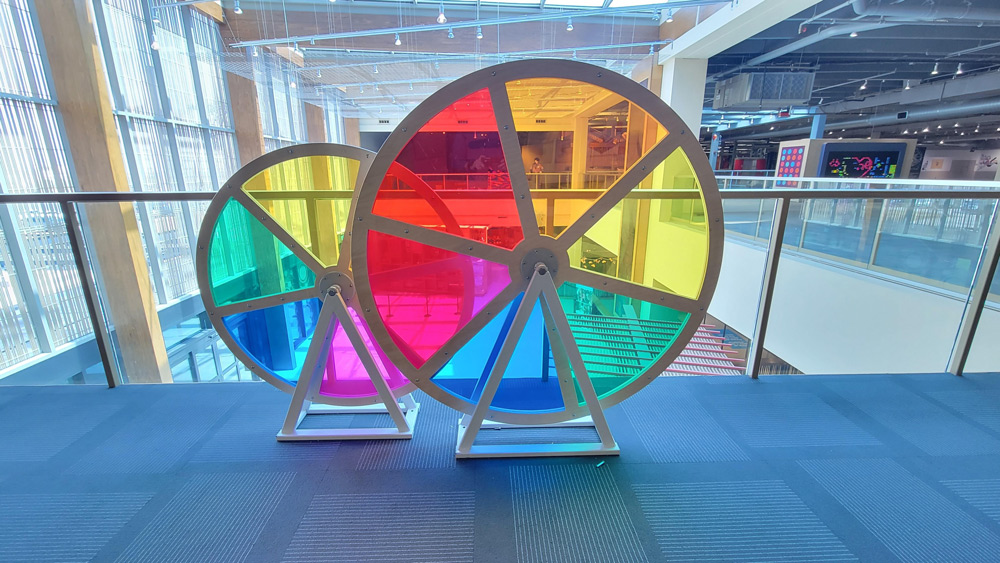Science Museum Oklahoma celebrates newest exhibit opening that connects art, science, color
April 5, 2022
Science Museum Oklahoma is celebrating the science of color with its newest exhibit, “Prismatic: A Faceted Experience of Color.”
“Prismatic” is on display in the museum’s smART Space galleries, which are dedicated to the intersection of art and science. The exhibit opening will be celebrated with a reception from 5:30 to 7 p.m. Monday, April 18. Admission to the reception is free but reservations are required; visitors can go to smo.org to reserve tickets.
Two of the contributing artists are scheduled to attend, deliver remarks, and visit with guests:
-
Laurie Frick is an artist based in Austin, Texas. She tells stories using data, an attempt to explain the world through large, hand-made patterned wall installations. She translates numbers into wood, paper, wool, leather, and glass patterns. Frick has three pieces in this show: “Felt Personality,” “Blue Heat,” and “Stress Inventory.” She will deliver remarks and visit with guests.
-
Sarah Hearn is an interdisciplinary artist, citizen scientist, and educator based in Kansas City, Missouri, but originally from Oklahoma. Her piece, “Astrobiological Futures,” imagines the landscapes of seven newly discovered planets orbiting the TRAPPIST-1 star in the constellation Aquarius. Astrobiological Futures is part of an ongoing science fiction body of work about space entitled “Out There.”
Also, the reception will feature a live musical performance by Gabriel Friedman. Friedman and partner Denise Duong recently installed their sculpture “The Little Creator” at Science Museum Oklahoma.
“Prismatic” explores how color can sway opinion, communicate without words, and even affect the body. Visitors will enter a space of striking color — a place to explore how this amazing force affects our world and how it has served as a muse for both historical and contemporary artists.
“The intersection of art and science gives us endless creativity, from artists interpreting our cosmos to scientists defining color,” smART Space Curator Alyson Atchison said. “As a child, colors were my tool for communication. Don’t get me started on how much I love yellow! I’m thrilled with this opportunity to explore color along with our community of guests at Science Museum Oklahoma. Watching younger children gravitate to this exhibition is a testament to the power of color.”
The exhibit includes several interactive elements, such as spinning color gel tiles, a prism light table, optical illusions, a colorblindness area, and giant color wheels.
In addition to Frick and Hearn, the show features Jesse Woolston, a composer and media artist from Auckland, New Zealand. His work, “The Dynamics of Flow,” is an audio/visual media installation that combines behaviors from maelstroms, tornados, supercells, and blackholes into a dynamic demonstration of our universal laws of flow. The work provides a new perspective on how we understand the scalability of our universe and the natural phenomena that occur around us every day. He also composed the soundtrack of the piece.
Science Museum Oklahoma is open from 9 a.m. to 5 p.m. Monday through Friday; 9 a.m. to 6 p.m. Saturday; and 11 a.m. to 6 p.m. Sunday. Daily general admission is $18.95 for adults (ages 13 to 64) and $14.95 for children (ages 3 to 12) and seniors (65 and older). Annual memberships begin at $115.
About Science Museum Oklahoma
Science Museum Oklahoma is the only hands-on science museum in Oklahoma and, with more than 390,000 square feet, one of the largest science museums in the nation. With a mission of sparking curiosity and encouraging learning by exploring the wonder and relevance of science, Science Museum Oklahoma demonstrates the relationship between the physical sciences and everyday experiences. The museum influences how Oklahomans learn about science through the medium of interactive exhibits, discovery-based activities, astronomy shows, Science Live demonstrations, educational outreach efforts and special events. The museum’s clear mission and firm focus on science literacy encourage families to develop and build upon a strong foundation in the sciences.


